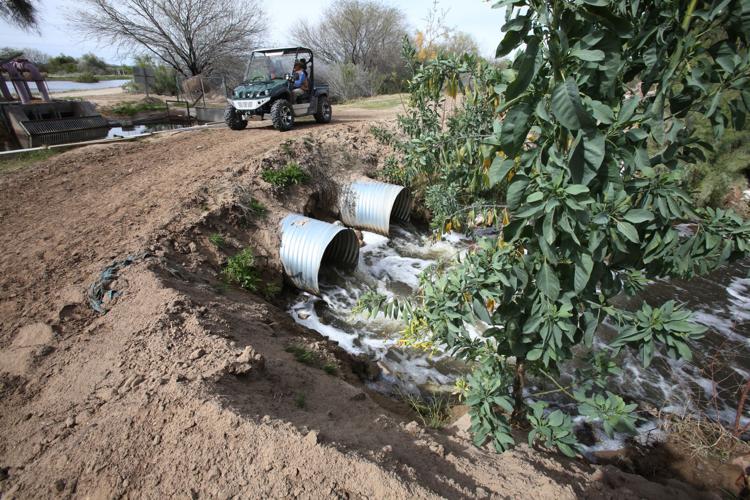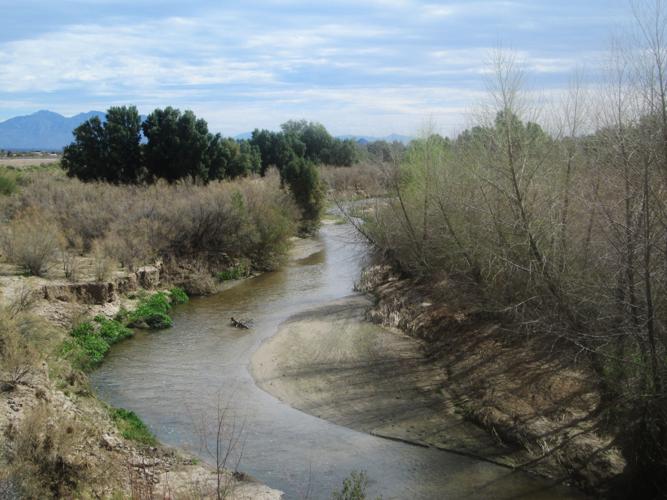The federal government may divert 70 percent of the treated wastewater flowing down the Santa Cruz River, most likely severely damaging some of the Tucson area’s richest riverfront habitat.
The U.S. Bureau of Reclamation says it will examine the possibility of taking all its effluent that is discharged into the river from two northwest-side sewage treatment plants. It says it needs to use it to raise money to meet obligations to the Tohono O’odham Nation. Bureau officials say they were frustrated by a Pima County Board of Supervisors decision last December to allow it to remove only a fraction of that effluent, and for only two years.
Removal of that much effluent would trigger a “huge decrease” in cottonwood-willow habitat that lines the river, said Claire Zugmeyer, a Sonoran Institute ecologist who has studied the Lower Santa Cruz downstream of the sewage plants for several years. The flow of effluent starts in the river at Roger Road, approximately, and goes north.
The bureau owns 28,200 acre-feet of total effluent, enough to supply more than 60 golf courses, and is already diverting a small portion.
“We might still have a little bit of habitat and streamflow, but it wouldn’t be the same,” said Zugmeyer, whose group annually publishes a “Living River” report, analyzing the Lower Santa Cruz’s health.
But bureau officials say they need to take out a significant amount of effluent to raise money to deliver a separate source of water — from the Central Arizona Project — to the Tohono O’Odham Nation’s San Xavier District south of Tucson. Due to a quirk in state law dealing with recharge and future pumping of effluent, the bureau can make twice as much money taking effluent out of the river than by leaving it in.
Restrictions county supervisors placed on the project would not have allowed enough time to determine if it works — only a year of operations after a year of preparation, said Lawrence Marquez, Native American programs manager in the bureau’s Phoenix office. Nor would it have raised enough money, said officials of the bureau and Metro Water, which was partnering with the federal agency on this project.
“This was always intended to be a pilot project. The limitations put on it were such that there was no value to it,” Marquez said. “We had been working with Pima County and our other partners for three years on this project.”
“We’ve always said our goal was to maximize value. In order to meet our obligations to the tribe, we need to get as close as we can to the value of (the total) 28,200 acre-feet.”
Removal of all the wastewater is far from certain. It would require a federal environmental impact statement, taking many months if not years to produce and discuss before a decision is made.
For now, environmentalists and officials will try to figure out how to raise money for the O’odham without having to “dewater” the Santa Cruz.
For instance, the environmentalist Community Water Coalition, a group that last year argued to limit effluent removal, says now that it sympathizes with the bureau’s concerns. It says its members and other entities involved agree that keeping effluent in the river and meeting the bureau’s obligations to the tribe aren’t mutually exclusive. It’s been meeting with bureau officials and other parties, seeking compromise.
A key to resolving the dispute is finding a way to change a decades-old law allowing for the sale of twice as many legal “credits” when effluent is recharged away from a river than into it.
Builders, cities and certain other entities buy credits to help prove to the state that their projects have assured water supplies, as required. They buy credits from others, such as the bureau, who recharge. Those credits are used to offset groundwater pumping impacts.
“If there was a way for us to get 28,200 acre-feet of credits by leaving it in the river, that would by far be the best for us,” Marquez said. “We wouldn’t have to spend any money and we could continue to do what we’re doing.”
One possibility could be for Tucson Water to take some bureau effluent out of the river and return it upstream, as part of its downtown-area Aqua Dulce project to restore water to the now-dry Santa Cruz there. Utility officials have discussed the idea with the bureau, and the federal agency is open to it, both parties said.
Although Aqua Dulce needs less than 20 percent of the bureau’s effluent, if it succeeds, “We could partner with the bureau on other projects,” said Tucson Water Director Tim Thomure. But he, too, wants full or nearly full credit for keeping effluent in the river.
He has discussed that idea with Arizona Department of Water Resources Director Tom Buschatzke, who is also open to it. Buschatzke said it’s possible something could be brought to the Legislature on the issue next year, but, “There’s a lot of different viewpoints and policy positions that need to be evaluated.”
FLOW ALREADY SHORTER
The Santa Cruz already isn’t flowing as far as it used to.
Since Pima County cleaned up wastewater discharges by rebuilding its sewage plants a few years ago under a federal mandate, cleaner water now recharges the aquifer much more readily. In other words, it seeps into the ground rather than running downstream.
As a result, where effluent once routinely reached the Trico Road bridge near Marana, the amount there dropped from 31,000 acre-feet in 2013 to 13,200 by 2015, the Sonoran Institute’s “Living River” report said. The difference went underground, through recharge.
A stark contrast shows in “before” and “after” pictures of the river at Trico-Marana Road, upstream of the bridge. Bright green shrubs and trees dominated a May 2013 photo; the same plants were brown and barren in June 2015. At the Trico Road bridge, the river had zero “dry days” in 2013, 94 in 2014 and 244 in 2015.
“If we remove more water from the river, the distance the water travels will get even shorter,” the institute’s Zugmeyer said.
A particularly acute risk faces the Oxbow, a 1.5-mile long channel diverted from the Santa Cruz. It supplies some county recharge basins and an Avra Valley-area rancher, Brad DeSpain, who diverts river water into the Oxbow to nourish pasture for his cattle. The channel, linking two stretches of Santa Cruz, is densely lined with mesquite, willow, tamarisk and other trees and shrubs, and draws many birds.
Overpumping payback
The money the bureau would raise by selling effluent credits would help meet U.S. legal obligations to the Tohono O’odham stemming from water-rights settlements passed to compensate for years of groundwater overpumping beneath the San Xavier District by Tucson and others.
To start this effort, the bureau and Metro Water worked out an arrangement to divert 2,200 acre-feet of effluent a year at first and 7,000 acre-feet later, over five years. It would have been piped to the Cortaro Marana Irrigation District downstream to irrigate crops in place of natural groundwater.
“This effort conserves groundwater and meets the regional goal of increasing beneficial use of effluent,” County Administrator Chuck Huckelberry said when recommending the project to supervisors.
But with support from environmentalists, the board voted to limit the project to 2,200 acre-feet of water and two years. “The board was trying to slow things down a little bit so we could come up with something better for health of the river,” Supervisor Richard Elías said.
In January, reclamation official Leslie Meyers wrote Huckelberry that the board’s decision to scale back the project damaged its economics.
In a recent newsletter, Metro Water criticized the Community Water Coalition for undercutting the project, costing the utility $200,000 in lost credit revenues.
The coalition declined to respond to that allegation. Huckelberry didn’t return a phone call or email from the Star seeking comment.
“We want the effluent recharged. But we want it at 100 percent in the river or as close to 100 percent as possible,” Elías said.







